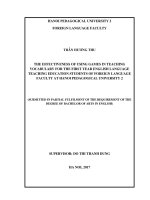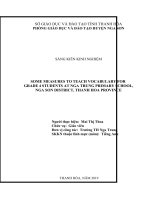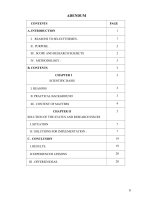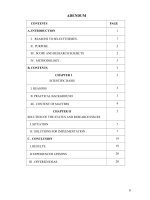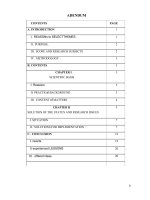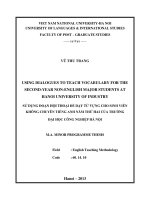Effective of using flashcard to teach vocabulary for kid
Bạn đang xem bản rút gọn của tài liệu. Xem và tải ngay bản đầy đủ của tài liệu tại đây (48.77 KB, 10 trang )
TABLE OF CONTENT
TABLE OF CONTENT...................................................................................i
INTRODUCTION...........................................................................................1
LITERATURE REVIEW...............................................................................2
1.
Vocabulary and Vocabulary Learning..........................................2
2.
Flashcard as a Teaching Strategy..................................................2
3.
Traditional Paper Flashcards.........................................................2
4.
Virtual Flashcards...........................................................................3
METHODOLOGY..........................................................................................5
RESULTS.........................................................................................................6
DISCUSSION..................................................................................................7
CONCLUSION................................................................................................8
REFERENCE..................................................................................................9
i
INTRODUCTION
1
LITERATURE REVIEW
1. Vocabulary and Vocabulary Learning
“Vocabulary is a list of words and their combination in particular
language”1. Vocabulary learning is important because it is needed by learners
to acquire a lot of words so they can use the vocabulary in any needs
especially academic needs. Vocabulary learning can be applied in classroom
activities by teachers by considering the level of language proficiency of the
students so a successfu and effective vocabulary learning can be reached.
2. Flashcard as a Teaching Strategy
“Flashcard is a cardboard consisting of a word, a sentence, or a simple
picture on it”2. Flashcard is considered as a helpful strategy because its
benefits. Moreover, teachers can also use flashcards for drilling and
presenting new words.
3. Traditional Paper Flashcards
“Traditional flashcards are made of paper and bear basic information,
such as a word and the associated image. Pupils generally like using
flashcards for selftesting purposes”3. Flashcards allow them to connect the
meaning of new words to simple pictures. Traditional flashcards can be used
in different ways to enhance children’s vocabulary learning, and many
researchers have conducted experiments and demonstrated the effectiveness
and helpfulness of traditional paper flashcards in language learning.
However, traditional paper flashcards have some limitations. For
example, the visual clues are only to the meaning of the words, and the
pronunciation remains absent. Children may find it hard to associate and
integrate the meaning of a word with its pronunciation. Moreover, traditional
Joklova, K. (2009). Using Pictures in Teaching Vocabulary.
Khodareza & Komachali, E. (2012). The Effect of Using Vocabulary Flashcard on Iranian on Iranian PreUniversity Students’ Vocabulary Knowledge. Canadian Center of Science and Education Journal.
3
Oxford & Crookall (1990) Vocabulary Learning: A Critical Analysis of Techniques
1
2
2
flashcard images are still, and therefore children’s perception of the
vocabulary may be limited to a certain perspective. They may not be able to
manipulate or expand the visual clues on the flashcards due to their
perceptions, and this could limit their engagement with traditional paper
flashcards.
4. Virtual Flashcards
“Since interaction is beneficial in terms of engaging learners with a
creative learning experience”4, flashcards with digital characteristics were
developed and applied to language learning. They are called virtual or digital
flashcards, come in various formats, and run on computers or mobile devices.
These virtual flashcards offer users all the necessary information, such as
words, images, pronunciations, animations and videos, and so on, to learn the
required vocabulary. For example, “ ” is a kind of
virtual flashcard website, with which users can learn words by listening to
their pronunciation. They can also view short animations to understand the
meaning of the vocabulary, and examples are offered of how the words are
used in sentences. As a virtual tool, “virtual flashcards can enrich the learning
experience through a double (visual and audio) channel”5. Animation and
videos also add fun to the learning process and lead to better learning
outcomes. Researchers have claimed that “ Virtual flashcards have a number
of advantages over traditional flashcards, and are a promising alternative
method to learn vocabulary.”6
However, virtual flashcards also have some shortcomings. First, they
are by necessity embedded in a computing device, and are therefore not easily
transportable, compared to traditional flashcards. Second, virtual pictures are
Li, S., Chen, Y., & Whittinghill, D. (2014). Exploring the potential for augmented reality to motivate
English vocabulary learning in Chinese college students.
5
Ruwe, K., McLaughlin, T. F., Derby, K. M., & Johnson, J. (2011). The multiple effects of direct instruction
flashcards on sight word acquisition, passage reading, and errors for three middle school students with
intellectual disabilities
6
Azabdaftari & Mozaheb, 2012,Comparing Vocabulary Learning of EFL Learners by Using Two Different
Strategies: Mobile Learning vs. Flashcards
4
3
two-dimensional (2D) and lack a three-dimensional (3D) perspective that
would give learners a more comprehensive view. Third, experiencing a
wholly virtual environment can be less instructive than experiencing a
combination of real and virtual worlds.
4
METHODOLOGY
5
RESULTS
6
DISCUSSION
7
CONCLUSION
8
REFERENCE
[1] Joklova, K. (2009). Using Pictures in Teaching Vocabulary.
[2] Khodareza & Komachali, E. (2012). The Effect of Using
Vocabulary Flashcard on Iranian on Iranian Pre-University Students’
Vocabulary Knowledge. Canadian Center of Science and Education Journal.
[3] Oxford & Crookall (1990) Vocabulary Learning: A Critical
Analysis of Techniques
[4] Li, S., Chen, Y., & Whittinghill, D. (2014). Exploring the potential
for augmented reality to motivate English vocabulary learning in Chinese
college students.
[5] Ruwe, K., McLaughlin, T. F., Derby, K. M., & Johnson, J. (2011).
The multiple effects of direct instruction flashcards on sight word acquisition,
passage reading, and errors for three middle school students with intellectual
disabilities
[6] Azabdaftari & Mozaheb, 2012,Comparing Vocabulary Learning of
EFL Learners by Using Two Different Strategies: Mobile Learning vs.
Flashcards
9

